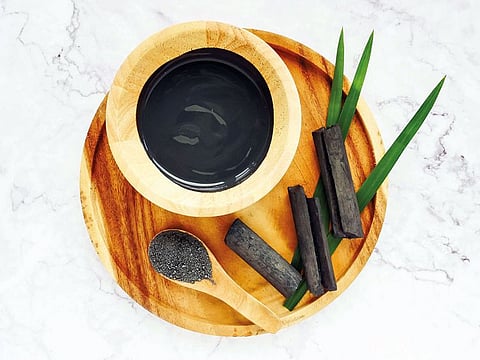Hear it from the experts: Seek advice before shopping for claims
There are better options available which can give long-term results, says dermatologist

DUBAI: Dr Mahaveer Mehta, Dubai-based dermatologist, clarifies the myths surrounding charcoal-based beauty products:
What is the hype about charcoal?
It is indeed hype. The fact is, many people are drawn to new claims and do not see that they could also be false assurances. Before deciding on any outcome with cosmetic products, people need to check with their dermatologist. It is the right of the consumer to seek answers and it is the duty of the specialist to provide the correct information. Of course, there may be some degree of difference of opinion from one dermatologist to another but the basic facts will be valuable.
What does activated charcoal do?
Activated charcoal is simply common charcoal that has been heated in a way that it develops a lot of small spaces or ‘pores’ within it that trap substances.
To ‘activate’ charcoal, steam or very hot air is used to erode the internal surfaces thereby increasing the absorptive surface area. This absorptive surface area is the one which draws out harmful substances, toxins and impurities from the skin. However, having said that, the effect is very minimal. There is no long-lasting impact of such usage.
Is there any harm in using such products?
If it is a quality product, it will not do any harm. But if it is a poor-quality product, then it can harm.
Is this a marketing gimmick?
I think it is a marketing gimmick. There are several better options, depending on skin condition, available in the market which can give long-term results without side-effects. There are also effective lasers and energy devices without any down time, less pain, and no side effects. Your dermatologist will advise what’s best for you.
Any scientific studies to prove charcoal’s efficacy in skincare?
In my opinion, there has not been any reputed scientific peer review in any medical journal.
What is the best way to ensure deep-pore cleansing?
Most cleansers’ formulations have bigger molecules than skin’s pore size and so clean only the surface of the skin. Glycolic acid, which is alpha hydroxy acid made from sugarcane, has smaller molecules than the skin’s pore size and is capable of deep-cleaning. So you can use a glycolic acid-based product [provided your dermatologist recommends it].
Is good, healthy skin about genes, environment or lifestyle?
It is a combination of all of these. I advise the following for healthy skin:
1. Use a glycolic acid-based cleanser.
2.Use oil-free, non-comedogenic (non-clogging), hypo-allergenic, fragrance-free products from reputed brands.
3. Avoid staying out in the sun. Use sun screen when outside.
4. Consult a dermatologist regularly. Every individual’s skin is different and it needs specific care.
5. Do regular exercise to energise skin.
6. Eat healthy; avoid oily/junk food.
7. Avoid stress.
8. Drink plenty of water every day.
Dr Adil Nadim Faridi, Dental Surgeon, Aster Hospital, Mankhool, clears the air on charcoal-based toothpastes:
How effective is charcoal for teeth whitening?
The use of charcoal is becoming a popular trend in dental care these days. Its use is associated with some oral benefits, however, it does pose a certain risk primarily due to its abrasive properties. Charcoal toothpaste contains activated charcoal. The use of activated charcoal started during the 20th century and was mostly recommended for tooth whitening purposes only.
Are there any risks in using charcoal-based toothpastes?
Recently, the American Dental Association (ADA) released warning against the use of charcoal-based toothpastes. The high abrasive nature erodes the enamel, leading to exposure of the inner layer known as dentine, thus damaging the teeth. Once the dentine is exposed, it leads to dental complications, tooth sensitivity, sharp pain.
It also causes dental erosion which is actually an irreversible loss of the tooth structure. It also increases the risk of accumulation, dental sensitivity and gingival recession, risk of caries, swelling of gums, trauma to the gums leading to the bleeding gum problems.
What is the Relative Dentine Abrasivity (RDA) of a toothpaste?
RDA is a standardised measurement of the abrasive effect that the components of the toothpaste have on a tooth. RDA scale was developed by the American Dental Association. The RDA scale compares toothpaste abrasivity to standard abrasive material and measures the depth of cut at an average of 1 millimetre/100,000 brush strokes on dentine. This comparison generates abrasive value that would be safe for daily use. It is usually better [for toothpastes] to have RDA level lower than 250. A value less than 150 is more safe.
What should one look for in a toothpaste?
Generally, an effective toothpaste must contain 1,350 to 1,500 parts per million (ppm) of fluoride to protect the teeth against decay. Toothpaste for children requires further consideration including American Dental Association (ADA) seal of acceptance.
Foods and drinks that stain teeth:
Excessive consumption of tea, coffee, coloured juices like pomegranate, smoking, sheesha and tobacco products, deeply coloured sauces, energy drinks, carbonated drinks, etc.
Home remedies for teeth whitening:
■ Brush teeth with baking soda, once a fortnight.
■ Oil pulling (swishing oil inside the mouth) is a traditional remedy. You can use sesame oil or coconut oil. Gargle with two per cent hydrogen peroxide mouthwash before brushing a couple of times weekly.
While these techniques may help with whitening in the short-term, it is better to consult your dentist because their long-term use can be damaging to teeth.
Sign up for the Daily Briefing
Get the latest news and updates straight to your inbox



